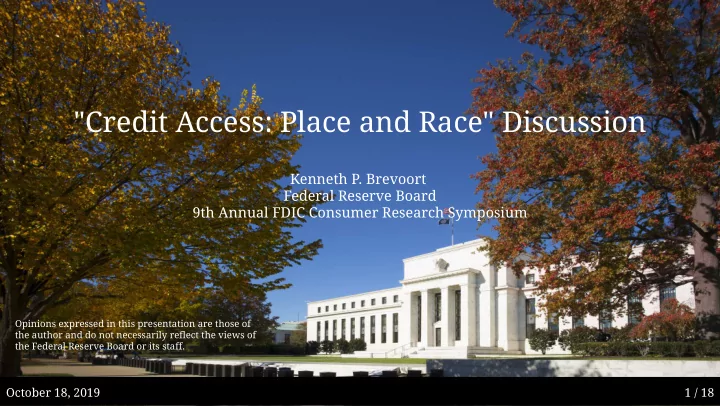

"Credit Access: Place and Race" Discussion Kenneth P. Brevoort Federal Reserve Board 9th Annual FDIC Consumer Research Symposium Opinions expressed in this presentation are those of the author and do not necessarily reflect the views of the Federal Reserve Board or its staff. October 18, 2019 1 / 18
Two Papers the Consumer Finance Policy Community Should Care About 1. Does the Community Reinvestment Act (CRA) Promote Small Business Growth in Lower-Income Neighborhoods? by Mee Jung Kim 2. Discrimination in the Auto Loan Market by Alexander W. Butler, Erik J. Mayer, and James P. Weston Both papers are notable, particularly for the new data they use. October 18, 2019 2 / 18
What Does Paper #1 Do? The CRA encourages lenders to meet the credit needs of their communities, including low-to-moderate income (LMI) neighborhoods LMI neighborhood is a Census tract with a median family income that is less than 80 percent of the median family income of the surrounding area. Uses a Regression Discontinuity Design (RDD) investigate whether outcomes differed right at the threshold used to delineate LMI neighborhoods Also uses Difference-in-Differences (DID) analysis of the RDD results October 18, 2019 3 / 18
Not the First Paper to Use RDD to Study CRA Bhutta (2011) looks at home mortgage lending October 18, 2019 4 / 18
Shameless Self Promotion Avery and Brevoort (2015) also looks at home mortgage loans October 18, 2019 5 / 18
So What Makes this Paper Notable? The Data Longitudinal Business Database (LBD) of the U.S. Census Bureau Covers all non-farm U.S. firms and establishments with employees Annually from 2004 to 2015 Also uses data on small business lending collected by FFIEC specifically for CRA October 18, 2019 6 / 18
The LBD Appears to Show Interesting CRA-Related Trends October 18, 2019 7 / 18
What Do the RDD Results Show? (Table 4) October 18, 2019 8 / 18
What Do the RDD Results Show? (Table 5) October 18, 2019 9 / 18
Why is this the Right Question? The unit of observation is the firm-year , meaning that the paper is focused on average firm size A richer set of measures might better show the effects of CRA: New firm formation Aggregate employment in small business sector Separate measures by industry Accept that CRA may not have had a measurable effect October 18, 2019 10 / 18
What Does Paper #2 Do? Provides a straight-forward analysis of racial and ethnic disparities in auto lending Looks for evidence of disparities in Denial rates Loan pricing/interest rates Default rates October 18, 2019 11 / 18
Investigating Discrimination in Auto Lending is Di�cult Unlike mortgages, there are no data combining auto loan information with racial or ethnic characteristics The CFPB Approach : Collect data from lenders on the loans they originate (excludes race/ethnicity) Use Bayesian Improved Surname Geocoding to make an educated guess about the race or ethnicity of the borrower October 18, 2019 12 / 18
Paper Builds Its Own Dataset Combines Two Primary Datasets: 1% sample of credit records from 2004-2017 (about 2.5 million people per year) Home Mortgage Disclosure Act (HMDA) data from 2010-2016 (about 46 million) Contributes Race/Ethnicity & Income To produce a dataset with 172,131 observation CFPB estimates there were 294 million auto loan originations from 2005-2017 Paper reports a "match rate" of 68.82% October 18, 2019 13 / 18
What the Paper Finds Conditional on credit score, income, age, sex, total debt, "debt-to-income" Minorities have a 1.5 percentage point lower acceptance rate (sample average 83.2 percent) Interest rates are 70 basis points higher for minorities (sample average 6%) Default rates are about 24bps lower for minorities The paper interprets these results as evidence of discrimination (e.g., "approximately 80,000 minority applicants fail to obtain auto loans each year due to discrimination") October 18, 2019 14 / 18
Deeper Question: What Is Discrimination? Equal Credit Opportunity Act (ECOA) : 15 U.S.C. § 1691 (a) Activities Constituting Discrimination It shall be unlawful for any creditor to discriminate against any applicant, with respect to any aspect of a credit transaction— (1) on the basis of race, color, religion, national origin, sex or marital status, or age (provided the applicant has the capacity to contract); (2) because all or part of the applicant’s income derives from any public assistance program; or (3) because the applicant has in good faith exercised any right under this chapter. October 18, 2019 15 / 18
Consider Two Scenarios 1. Consumers live in (incompletely) segregated neighborhoods and there are two lenders. One lender is located in a neighborhood with high-minority concentration and charges an interest rate of 10% on every auto loan it makes; The other lender locates in a low-minority neighborhood and charges 5% on every loan. 2. A single lender charges 10% on auto loans for used cars and 5% on loans for new cars. Minorities are more likely to buy used cars. Both scenarios would produce the same results reported in the paper: Minorities pay higher interest rates. But all lenders treat all borrowers the same. October 18, 2019 16 / 18
Why this Matters An argument can be made that it doesn't (disparities matter). Minorities are paying more on average as a group But then why condition on credit score and income? The right policy approaches to mitigating the disparities will depend critically on the causes of the disparities October 18, 2019 17 / 18
Summary These are two interesting and policy-relevant papers that bring new data to bear on long-standing policy questions Both papers would benefit from additional content Does the Community Reinvestment Act (CRA) Promote Small Business Growth in Lower-Income Neighborhoods? Look at a broader selection of outcomes than average firm size Discrimination in the Auto Loan Market Establish that the data used remain representative and informative about underwriting decisions Distinguish discrimination by lenders from broader issue of disparities October 18, 2019 18 / 18
Recommend
More recommend